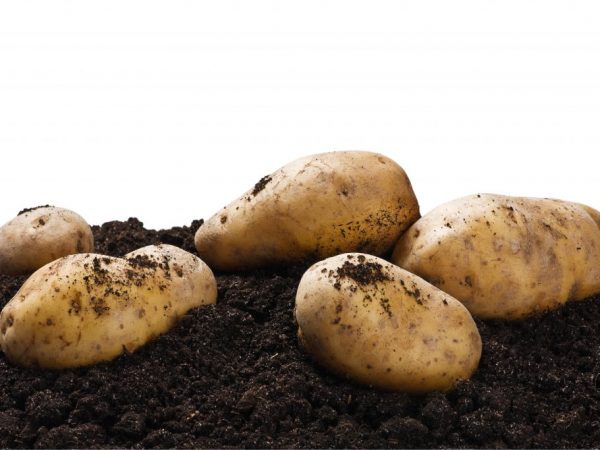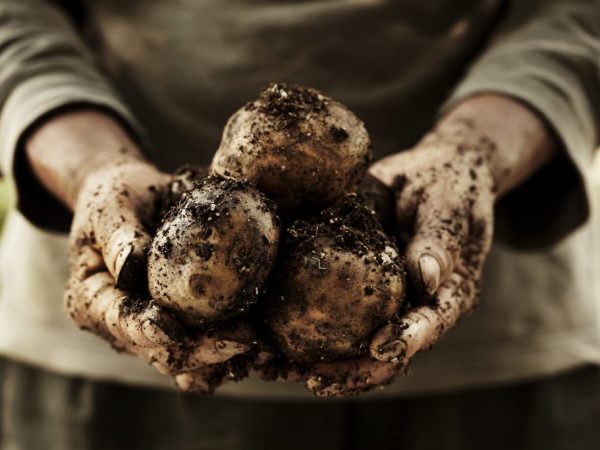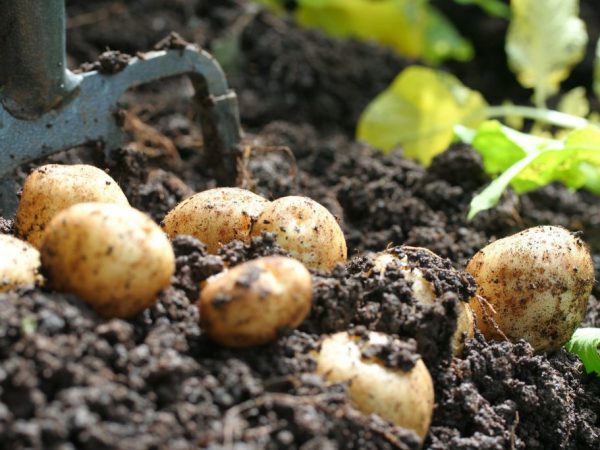Description of potato varieties for the Chernozem region
The Black Earth Region is a fertile region for growing potatoes. It is important to choose high-quality potato varieties for the Chernozem region. Suitable and worthy planting material will delight you with high yields and quality characteristics. It is important to choose the one that will satisfy all the requirements of each individual gardener as much as possible.

Description of potato varieties for the Chernozem region
How to choose good potato varieties for the Black Earth Region
Important characteristics to look out for when choosing a variety:
- zoning;
- yield;
- the size of the tubers;
- ripening time;
- disease resistance;
- taste qualities.
Good potato varieties for growing in the Black Earth Region, those that are bred and tested in the middle climatic zone, should not choose plants intended for planting in the southern regions.
Yield
It is important to pay attention to what kind of yield and choose according to your own requirements. The sizes of tubers also differ. Having invested so much work in growing, small potatoes will be a complete disappointment.
Maturation
The ripening time of potatoes is not unimportant. Using early maturing species, you can harvest twice a season, this is a very important indicator, especially for industrial cultivation. But the late species are remarkably stored and will provide tasty root crops until the next season.
Disease resistance
Despite favorable conditions, potatoes can be affected by diseases, therefore, resistance to various diseases plays an important role. And in case of infection, the bushes weaken and small potatoes grow. You should choose those that are resistant to different types of disease. Taste characteristics are also important, especially given its widespread use in cooking.
The choice of planting material

We select potatoes
Having chosen the perfect variety, you should understand how to choose high-quality planting material. The following characteristics of high-quality tubers for planting can be distinguished:
- the size;
- the number of rudimentary eyes;
- correct shape;
- absence of traces of the disease;
- no damage.
The quality of the planting potatoes will have a positive effect on the future harvest. Root crops should be medium in size, small potatoes will not produce a high-quality crop, and large tubers are also not suitable. The buds on the potato should be from 2 to 5, this will make it possible to develop a strong ground part of the plant, and in turn the rhizome with tubers will have the appropriate size.
The shape and color of the fruit must match the description. A bad sign is a deformed tuber of irregular shape; such planting material should not be planted in a garden bed. Also, traces of diseases (scab, late blight, rot) should not be traced. The presence of even one infected specimen leads to the defeat of the rest and, as a result, weak plants and poor quality harvest.Healthy seeds are the key to healthy offspring.
Mechanically damaged tubers are also not suitable for planting, often after planting they rot and do not germinate. Planting potatoes, even elite ones, should be of the highest quality. It is worth choosing the best specimens from planting potatoes.
The best potato varieties for the Chernozem region
From a large number of varieties suitable for the Chernozem region, it is worth highlighting the best ones, those that have positively proven themselves in amateur gardening and industrial cultivation. They have their own advantages and features.
Excellence
One of the new ones. Bred and registered not so long ago. Root crops have an average weight of 200-220 grams, elongated with a beautiful oval shape. The skin and flesh of the tuber are yellow.
It has excellent taste, it belongs to the mid-season table varieties. Used in industry for the production of various snacks and potato semi-finished products. This species is resistant to nematodes and potato crayfish.
The disadvantages of this species include poor resistance to late blight of the aerial part of the plant. Requires germination before planting in the ground. Germinates for a long time at low soil temperatures.
Red Scarlet
The species was bred in the Netherlands. It has a short ripening period of up to 75 days. The skin has a characteristic red color, and the flesh is close to yellow in color. The shape is elongated, oval with regular outlines. The bushes are not tall.

Good yield
It has established itself due to its high yield and early maturity. The yield of the variety is up to 6 t / ha. Up to 20 potatoes ripen under one bush with an average weight of 95 grams. It tolerates unfavorable weather conditions. It does not stop growing even in drought. Red Scarlet is resistant to tuberous late blight. And also root crops have an increased shelf life, which is rare for early potatoes.
The disadvantages of Red Scarlet include the need to update the planting material due to possible degeneration and loss of qualities. This variety is not resistant to scab and alternalosis.
Lorch
The variety was bred and registered in 1931. Refers to potatoes with a medium late ripening period. The tuber shape is often round, the skin is beige, the flesh is white. It tastes good.
There are many advantages that prevent it from losing popularity over the years. The variety is also undemanding to growing conditions. species resistant to drought and high temperatures. Produces a high-quality crop even on depleted soils. It is resistant to the widespread disease late blight.
With disadvantages, high starchiness up to 20% is emitted, which leads to loss of shape during cooking. But this disadvantage makes it possible to use the variety in the production of starch. Root crops are not large in size, on average, up to 75 grams. Lorkh is prone to diseases such as scab and cancer.
September
Refers to medium early. The shape is often rounded. The average tuber weight is 120 grams. The skin is yellow and the middle is white.
High yield is distinguished from advantages, which is 400-450 c / ha. September is resistant to late blight and potato crayfish. Grows well on different types of soil. Resistant to sudden changes in temperature.
With all the positive qualities, a tendency to infection with a nematode is noted. That requires additional preventive treatment of bushes.
Riviera
Super early, Dutch selection. The color is light yellow, the flesh is creamy. Root weight up to 180 grams. Productivity is 4-5 tons per hectare.
The first harvest Riviera gives 40-45 days from germination. Which plays a huge role in industrial cultivation. Allows planting twice a day to provide a market for the sale of young potatoes. High yield makes it possible to collect about 12 fruits from one bush. And this advantage is valuable even for those who grow several bushes in the country.
A quality variety, but has medium resistance to many diseases and requires fungicide treatment and careful maintenance.
Zekura
Late variety for universal use. Has a yellowish flesh and rind. The bush is medium erect. The mass of root crops reaches 140 grams.
Upright bushes make weeding and maintenance easy. The Zekura variety is undemanding to conditions. Potato nests are located close to the surface for easy digging. The long shelf life allows it to be used until late spring. It is appreciated for its taste and is widely used in cooking.
Even with such numerous advantages, Zekura gives low yields in drought conditions. And the roots grow small, weighing 45-65 grams.
Conclusion
The number of varieties at the moment is huge, and breeders continue to work tirelessly in this field, cultivating new ones to create the best ones. It is important to understand what features and qualities to pay attention to. And choose a potato variety that will be fruitful, resistant to diseases, have the appropriate taste, and as a result, in the fall, it will bring pleasure and positive from the work done.


